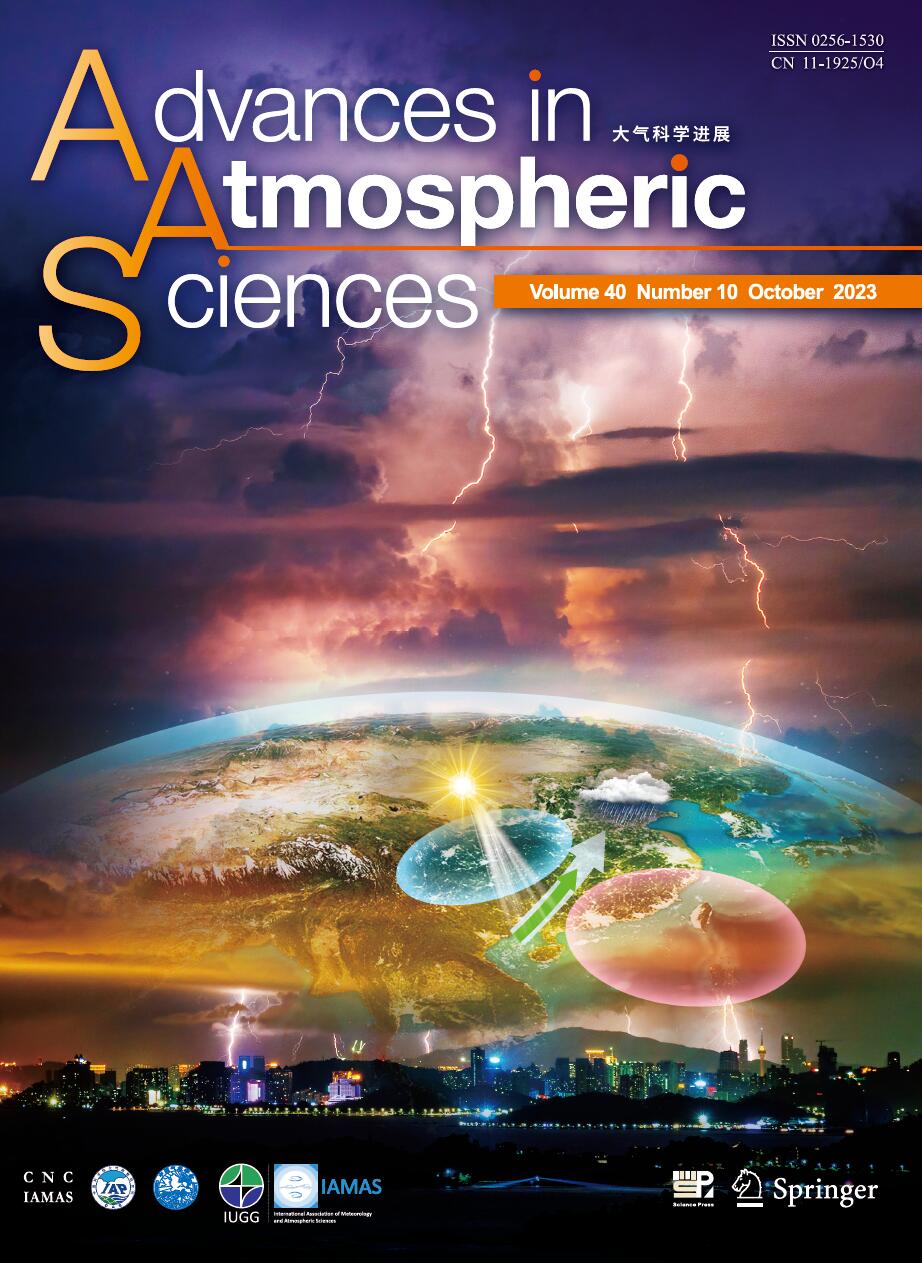| [1] |
Mozheng Wei,
1996: A Low-order Model of Two-dimensional Fluid Dynamics on the Surface of a Sphere, ADVANCES IN ATMOSPHERIC SCIENCES, 13, 67-90.
doi: 10.1007/BF02657029
|
| [2] |
Zhangcai QIN, Xi DENG, Bronson GRISCOM, Yao HUANG, Tingting LI, Pete SMITH, Wenping YUAN, Wen ZHANG,
2021: Natural Climate Solutions for China: The Last Mile to Carbon Neutrality, ADVANCES IN ATMOSPHERIC SCIENCES, 38, 889-895.
doi: 10.1007/s00376-021-1031-0
|
| [3] |
Yong. L. McHall,
1990: Generalized Available Potential Energy, ADVANCES IN ATMOSPHERIC SCIENCES, 7, 395-408.
doi: 10.1007/BF03008870
|
| [4] |
ZHANG Ming, ZHAO Yanling, HUANG Hong, LIANG Danqing,
2007: The Generalized Energy Equation and Instability in the Two-layer Barotropic Vortex, ADVANCES IN ATMOSPHERIC SCIENCES, 24, 147-151.
doi: 10.1007/s00376-007-0147-1
|
| [5] |
Ji Zhongzhen, Wang Bin, Zhao Ying, Yang Hongwei,
2002: Total Energy Conservation and the Symplectic Algorithm, ADVANCES IN ATMOSPHERIC SCIENCES, 19, 459-467.
doi: 10.1007/s00376-002-0079-8
|
| [6] |
Li Hongji, Xu Hong, Wang Ronghua,
1988: A HIGH-RESOLUTION ANALYSIS METHOD OF INSTABILITY ENERGY, ADVANCES IN ATMOSPHERIC SCIENCES, 5, 75-86.
doi: 10.1007/BF02657348
|
| [7] |
Shou Shaowen, Li Shenshen,
1991: Diagnosis of Kinetic Energy Balance of a Decaying Onland Typhoon, ADVANCES IN ATMOSPHERIC SCIENCES, 8, 479-488.
doi: 10.1007/BF02919270
|
| [8] |
Runkua Yang, J. Shukla, P.J. Sellers,
1994: The Influence of Changes in Vegetation Type on the Surface Energy Budget, ADVANCES IN ATMOSPHERIC SCIENCES, 11, 139-161.
doi: 10.1007/BF02666542
|
| [9] |
Yuan Zhuojian, Jian Maoqiu,
2001: Diagnostic Equations for the Walker Circulation, ADVANCES IN ATMOSPHERIC SCIENCES, 18, 166-178.
doi: 10.1007/s00376-001-0011-7
|
| [10] |
Baofeng JIAO, Lingkun RAN, Na LI, Ren CAI, Tao QU, Yushu ZHOU,
2023: Comparative Analysis of the Generalized Omega Equation and Generalized Vertical Motion Equation, ADVANCES IN ATMOSPHERIC SCIENCES, 40, 856-873.
doi: 10.1007/s00376-022-1435-5
|
| [11] |
Yaokun LI, Jiping CHAO, Yanyan KANG,
2021: Variations in Wave Energy and Amplitudes along the Energy Dispersion Paths of Nonstationary Barotropic Rossby Waves, ADVANCES IN ATMOSPHERIC SCIENCES, 38, 49-64.
doi: 10.1007/s00376-020-0084-9
|
| [12] |
Yaokun LI, Jiping CHAO, Yanyan KANG,
2022: Variations in Amplitudes and Wave Energy along the Energy Dispersion Paths for Rossby Waves in the Quasigeostrophic Barotropic Model, ADVANCES IN ATMOSPHERIC SCIENCES, 39, 876-888.
doi: 10.1007/s00376-021-1244-2
|
| [13] |
Qiu Yongyan,
1993: On the Seasonal Transition and the Interannual Variability in Global Kinetic Energy at 500 hPa, Accompanied with Anomalies of Energy during the 1982 / 83 ENSO, ADVANCES IN ATMOSPHERIC SCIENCES, 10, 248-256.
doi: 10.1007/BF02919148
|
| [14] |
GAO Shouting, XU Pengcheng, LI Na,
2012: On the Generalized Ertel--Rossby Invariant, ADVANCES IN ATMOSPHERIC SCIENCES, 29, 690-694.
doi: 10.1007/s00376-012-1145-5
|
| [15] |
YANG Shuai, GAO Shouting, LU Chungu,
2014: A Generalized Frontogenesis Function and Its Application, ADVANCES IN ATMOSPHERIC SCIENCES, 31, 1065-1078.
doi: 10.1007/s00376-014-3228-y
|
| [16] |
LU Weisong, SHAO Haiyan,
2003: Generalized Nonlinear Subcritical Symmetric Instability, ADVANCES IN ATMOSPHERIC SCIENCES, 20, 623-630.
doi: 10.1007/BF02915505
|
| [17] |
Liu Yangang,
1995: On the Generalized Theory of Atmospheric Particle Systems, ADVANCES IN ATMOSPHERIC SCIENCES, 12, 419-438.
doi: 10.1007/BF02657003
|
| [18] |
Xinping XU, Shengping HE, Huijun WANG,
2020: Relationship between Solar Wind−Magnetosphere Energy and Eurasian Winter Cold Events, ADVANCES IN ATMOSPHERIC SCIENCES, 37, 652-661.
doi: 10.1007/s00376-020-9153-3
|
| [19] |
Xiang Jie, Sun Litan,
2002: Nonlinear Saturation of Baroclinic Instability in the Phillips Model: The Case of Energy, ADVANCES IN ATMOSPHERIC SCIENCES, 19, 1079-1090.
doi: 10.1007/s00376-002-0066-0
|
| [20] |
ZUO Qunjie, GAO Shouting, and LÜ Daren,
2014: Eddy Kinetic Energy Study of the Snowstorm over Southern China in January 2008, ADVANCES IN ATMOSPHERIC SCIENCES, 31, 972-984.
doi: 10.1007/s00376-013-3122-z
|















 AAS Website
AAS Website 
 AAS WeChat
AAS WeChat 
 DownLoad:
DownLoad: